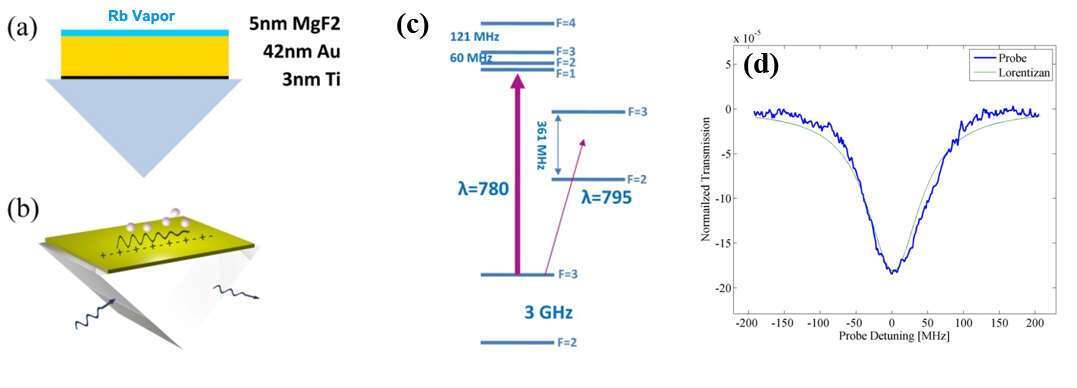
Fano-EIT Transmission Windows in Plasmonic-Vapor Vee Type System
Photonic and plasmonic systems exhibiting Fano resonances are attracting growing attention in recent years [1]. The combination of a Fano resonance, with V-type 3 level atomic scheme, results in a novel and fascinating test bed for fundamental aspects in light-vapor interaction. Due to the strong field enhancement and consequent large attainable Rabi frequencies, the interplay between phenomena such as electro-magnetic induced transparency (EIT), velocity selective optical pumping (VSOP) and saturation can be observed.
Recently, we have demonstrated the resonant coupling of surface plasmon resonance and rubidium atomic vapor hybrid system. Furthermore, we have shown the Fano nature of such coupling as well as the capability to control the Fano lineshape all optically [2].
Here, we use this hybrid system (Illustrated in Fig. 1a and 1b) to study the character of the plasmonic-atomic system, utilized as a 3 level V-scheme pump-probe apparatus (the level scheme is illustrated in Fig. 1c). We show that 90 MHz sub Doppler dips are attainable. Interestingly, we observed a unique property in which specific transitions appear as EIT transmission windows, while other transitions are totally suppressed. As these peaks are also subject to the Fano mechanism, they appear as inverted transmission windows, as shown in Fig 1d, where a non-suppressed peak (corresponding to the F=3 to F`=4 transition) is shown. We attribute this general supersession and inhibition of transmission peaks to the interaction interplay between saturation, VSOP and EIT unique to plasmonic-atomic system. Finally, we have applied an external magnetic field and observe unique selection rules due to the longitudinal electric field component of the SPP.
The presented platform is expected to play a significant role in studying the basic mechanisms involved in such interactions, and as a test bed for exploring the nature of atomic interactions in the vicinity of metal surfaces. It can also serve as an important building block in applications e.g. frequency standards, time delay, magnetic field sensing, and all optical switching.

References
[1] Luk’yanchuk, B. et al.The Fano resonance in plasmonic nanostructures and metamaterials.Nat Mater 9, 707–715 (2010).
[2] L. Stern, M. Grajower, and U. Levy, Fano resonances and all-optical switching in a resonantly coupled plasmonicatomic system, Nature Commun 5, (2014).
liron.stern@mail.huji.ac.il
Powered by Eventact EMS